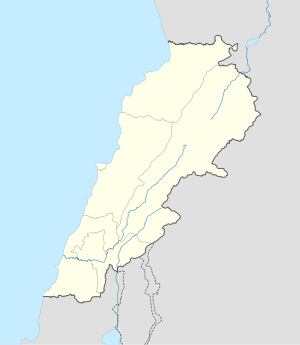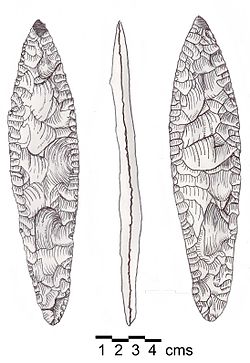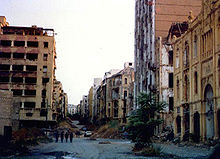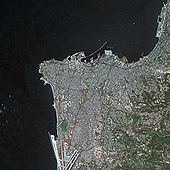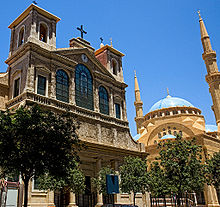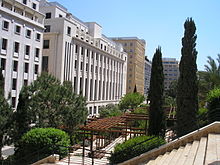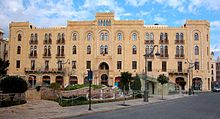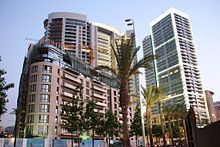
Beirut
Background Information
The articles in this Schools selection have been arranged by curriculum topic thanks to SOS Children volunteers. A good way to help other children is by sponsoring a child
Coordinates: 33°53′13″N 35°30′47″E
| Beirut بيروت Beyrouth |
|||
|---|---|---|---|
|
|||
|
|
|||
| Coordinates: 33°53′13″N 35°30′47″E | |||
| Country | Lebanon | ||
| Governorate | Beirut, Capital City | ||
| Government | |||
| • Mayor | Bilal Hamad | ||
| Area | |||
| • City | 20 km2 (8 sq mi) | ||
| • Urban | 100 km2 (40 sq mi) | ||
| • Metro | 200 km2 (80 sq mi) | ||
| Elevation | 0 m (0 ft) | ||
| Population (2012) | |||
| • City | 361,366 (UN) | ||
| • Urban | 1,900,000 | ||
| • Metro | 2,063,363 | ||
| Demonym | Beiruti | ||
| Time zone | +2 | ||
| • Summer ( DST) | +3 ( UTC) | ||
| Area code(s) | 961 | ||
| Website | City of Beirut | ||
Beirut (Arabic: بيروت Bayrūt, Greek: Βηρυττός, Latin: Berytus, Aramaic: Birot בירות, French: Beyrouth, Turkish: Beyrut) is the capital and largest city of Lebanon. As there has been no recent population census, the exact population is unknown; estimates in 2007 ranged from slightly more than 1 million to slightly less than 2 million. Located on a peninsula at the midpoint of Lebanon's Mediterranean coast, it serves as the country's largest and main seaport. The Beirut metropolitan area consists of the city and its suburbs. The first mention of this metropolis is found in the ancient Egyptian Tell el Amarna letters, dating from the 15th century BC. The city has been inhabited continuously since then.
Beirut is Lebanon's seat of government and plays a central role in the Lebanese economy, with many banks and corporations based in its Central District, Hamra Street, Rue Verdun and Ashrafieh. The city is the focal point of the region's cultural life, renowned for its press, theatres, cultural activities and nightlife. After the destructive Lebanese Civil War, Beirut underwent major reconstruction, and the redesigned historic city centre, marina, pubs and nightlife districts have once again made it a tourist attraction.
Beirut was named the top place to visit by The New York Times in 2009, and as one of the ten liveliest cities in the world by Lonely Planet in the same year.
In 2011 MasterCard Index revealed that Beirut had the second-highest visitor spending levels in the Middle East and Africa, totaling $6.5 billion.
Archaeology and prehistory
Several prehistoric archaeological sites were discovered within the urban area of Beirut, revealing flint tools of sequential periods dating from the Middle Paleolithic and Upper Paleolithic, and through the Neolithic to the Bronze Age.
Beirut I, or Minet el Hosn, was listed as "Beyrouth ville" by Louis Burkhalter and said to be on the beach near the Orent and Bassoul hotels on the Avenue des Français in central Beirut. The site was discovered by Lortet in 1894 and discussed by Godefroy Zumoffen in 1900. The flint industry from the site was described as Mousterian and is held by the Museum of Fine Arts of Lyon.
Beirut II, or Umm el Khatib, was suggested by Burkhalter to have been north of Tarik el Jedideh, where P.E. Gigues discovered a Copper Age flint industry at around one hundred meters above sea level. The site was built on and destroyed by 1948.
Beirut III, Furn esh Shebbak or Plateau Tabet, was suggested to have been located on the left bank of the Beirut River. Burkhalter suggested that it was west of the Damascus road, although this determination has been criticized by Lorraine Copeland. P. E. Gigues discovered a series of Neolithic flint tools on the surface along with the remains of a structure suggested to be a hut circle. Auguste Bergy discussed polished axes that were also found at this site, which has now completely disappeared as a result of construction and urbanization of the area.
Beirut IV, or Furn esh Shebbak, river banks, was also on the left bank of the river and on either side of the road leading eastwards from the Furn esh Shebbak police station towards the river that marked the city limits. The area was covered in red sand that represented Quaternary river terraces. The site was found by Jesuit Father Dillenseger and published by fellow Jesuits Godefroy Zumoffen, Raoul Describes and Auguste Bergy. Collections from the site were made by Bergy, Describes and another Jesuit, Paul Bovier-Lapierre. A large number of Middle Paleolithic flint tools were found on the surface and in side gullies that drain into the river. They included around 50 varied bifaces accredited to the Acheulean period, some with a lustrous sheen, now held at the Museum of Lebanese Prehistory. Henri Fleisch also found an Emireh point amongst material from the site, which has now disappeared beneath buildings.
Beirut V, or Nahr Beirut (Beirut River), was discovered by Dillenseger and said to be in an orchard of mulberry trees on the left bank of the river, near the river mouth, and to be close to the railway station and bridge to Tripoli. Levallois flints and bones and similar surface material were found amongst brecciated deposits. The area has now been built on.
Beirut VI, or Patriarchate, was a site discovered while building on the property of the Lebanese Evangelical School for Girls in the Patriarchate area of Beirut. It was notable for the discovery of a finely styled Canaanean blade javelin suggested to date to the Néolithique Ancien or Néolithique Moyen periods of Byblos and which is held in the school library.
Beirut VII, or Rivoli Cinema and Byblos Cinema sites near the Bourj in the Rue el Arz area, are two sites discovered by Lorraine Copeland and Peter Wescombe in 1964 and examined by Diana Kirkbride and Roger Saidah. One site was behind the parking lot of the Byblos Cinema and showed collapsed walls, pits, floors, charcoal, pottery and flints. The other, overlooking a cliff west of the Rivoli Cinema, was composed of three layers resting on limestone bedrock. Fragments of blades and broad flakes were recovered from the first layer of black soil, above which some Bronze Age pottery was recovered in a layer of grey soil. Pieces of Roman pottery and mosaics were found in the upper layer. Middle Bronze Age tombs were found in this area, and the ancient tell of Beirut is thought to be in the Bourj area.#
The Phoenician port of Beirut was located between Rue Foch and Rue Allenby. The port or harbour was excavated and reported on several years ago and now lies buried under the city. Another suggested port or dry dock was claimed to have been discovered in 2011 by a team of Lebanese archaeologists from the Directorate General of Antiquities under Hicham Sayegh, a B.A. graduate from the Lebanese University. Controversy arose on 26 June 2012 when authorization was given by Lebanese Minister of Culture Gaby Layoun for a private company called Venus Towers Real Estate Development Company to destroy the ruins (archaeological site BEY194) in the $500 million construction project of three skyscrapers and a garden behind Hotel Monroe in downtown Beirut. Two later reports by an international committee of archaeologists appointed by Layoun, including Hanz Curver, and an expert report by Ralph Pederson, a member of the institute of Nautical Archaeology and now teaching at Marburg in Germany, dismissed the claims that the trenches were a port, on various criteria. The exact function of site BEY194 may now never be discovered, and the issue raised heated emotions and led to increased coverage on the subject of Lebanese heritage in the press.
History
Beirut's history goes back more than 5,000 years. According to the Encyclopædia Britannica, its antiquity is indicated by its name, derived from the Canaanite be'erot ("wells"), referring to the underground water table that is still tapped by the local inhabitants for general use. Excavations in the downtown area have unearthed layers of Phoenician, Hellenistic, Roman, Byzantine, Arab, Crusader and Ottoman remains. The first historical reference to Beirut dates from the 14th century BC, when it is mentioned in the cuneiform tablets of the Amarna letters, three letters that Ammunira of Biruta (Beirut) sent to the pharaoh of Egypt. Biruta is also referenced in the letters from Rib-Hadda, king of Byblos. The oldest settlement was on an island in the river that progressively silted up. The city was known in antiquity as Berytus. This name was taken in 1934 for the archaeological journal published by the Faculty of Arts and Sciences at the American University of Beirut.
Hellenistic/Roman period
In 140 BC the city was destroyed by Diodotus Tryphon in his contest with Antiochus VII Sidetes for the throne of the Macedonian Seleucid monarchy. Beirut was soon rebuilt on a more conventional Hellenistic plan and renamed Laodicea in Phoenicia (Greek: Λαοδικεια ή του Φοινίκη) or Laodicea in Canaan in honour of a Seleucid Laodice. The modern city overlies the ancient one, and little archaeology was carried out until after the end of the civil war in 1991. Large sites in the devastated city centre have now been opened to archaeological exploration. A dig in 1994 established that one of Beirut's modern streets, Souk Tawile, still follows the lines of an ancient Greek and Roman one.
Mid first century coins from Berytus bear the head of Tyche, goddess of fortune; on the reverse, the city's symbol appears: a dolphin entwines an anchor. This symbol was taken up by the early printer Aldus Manutius in 15th century Venice. Beirut was conquered by Agrippa in 64 BC. The city was assimilated into the Roman Empire, veteran soldiers were sent there, and large building projects were undertaken. Beirut was considered the most Roman city in the eastern provinces of the Roman Empire.
In 14 BC, during the reign of Herod the Great, Berytus became a colonia and was named Colonia Iulia Augusta Felix Berytus. Its law school was widely known; two of Rome's most famous jurists, Papinian and Ulpian, both natives of Phoenicia, taught there under the Severan emperors. When Justinian assembled his Pandects in the 6th century, a large part of the corpus of laws was derived from these two jurists, and in 533 Justinian recognized the school as one of the three official law schools of the empire. After the 551 Beirut earthquake the students were transferred to Sidon.
Middle Ages
Beirut passed into Arab control in 635 and was ruled by the Arslan Family, Arabs from Yemen descended from the Lakhmids, from 635 to 1110. Prince Arslan bin al-Mundhir founded the Principality of Sin-el-Fil in Beirut in 759 AD. From this principality developed the later Principality of Mount Lebanon, which was the basis for the establishment of Greater Lebanon, today's Lebanon. As a trading centre of the eastern Mediterranean, Beirut was overshadowed by Acre during the Middle Ages. From 1110 to 1291 it was in the hands of the Crusaders' Kingdom of Jerusalem. John of Ibelin, the Old Lord of Beirut (1179–1236) rebuilt the city after the battles with Saladin and also built the Ibelin family palace in Beirut.
Ottoman rule
Beirut was controlled by local Druze emirs throughout the Ottoman period. One of them, Fakhr-al-Din II, fortified it early in the 17th century, but the Ottomans reclaimed it in 1763. With the help of Damascus, Beirut successfully broke Acre's monopoly on Syrian maritime trade and for a few years supplanted it as the main trading centre in the region. During the succeeding epoch of rebellion against Ottoman hegemony in Acre under Jezzar Pasha and Abdullah Pasha, Beirut declined to a small town with a population of about 10,000 and was an object of contention between the Ottomans, the local Druze, and the Mamluks. After Ibrahim Pasha of Egypt captured Acre in 1832, Beirut began its revival.
By the second half of the nineteenth century, Beirut was developing close commercial and political ties with European imperial powers, particularly France. European interests in Lebanese silk and other export products transformed the city into a major port and commercial centre. Meanwhile, Ottoman power in the region continued to decline. Sectarian and religious conflicts, power vacuums, and changes in the political dynamics of the region culminated in the 1860 Lebanon conflict. Beirut became a destination for Maronite Christian refugees fleeing from the worst areas of the fighting on Mount Lebanon and in Damascus. This in turn altered the ethnic composition of Beirut itself, sowing the seeds of future ethnic and religious troubles there and in greater Lebanon. However, Beirut was able to prosper in the meantime. This was again a product of European intervention, and also a general realization amongst the city's residents that commerce, trade, and prosperity depended on domestic stability.
In 1888, Beirut was made capital of a vilayet (governorate) in Syria, including the sanjaks (prefectures) Latakia, Tripoli, Beirut, Acre and Bekaa. By this time, Beirut had grown into a very cosmopolitan city and had close links with Europe and the United States. It also became a centre of missionary activity that spawned impressive educational institutions, such as the American University of Beirut. Provided with water from a British company and gas from a French one, silk exports to Europe came to dominate the local economy. After French engineers established a modern harbour in 1894 and a rail link across Lebanon to Damascus and Aleppo in 1907, much of the trade was carried by French ships to Marseille. French influence in the area soon exceeded that of any other European power. The 1911 Encyclopædia Britannica reported a population consisting of 36,000 Muslims, 77,000 Christians, 2,500 Jews, 400 Druze and 4,100 foreigners. At the start of the 20th century, Salim Ali Salam was one of the most prominent figures in Beirut, holding numerous public positions including deputy from Beirut to the Ottoman parliament and President of the Municipality of Beirut. Given his modern way of life, the emergence of Salim Ali Salam as a public figure constituted a transformation in terms of the social development of the city.
Modern era
After the collapse of the Ottoman Empire following World War I, Beirut, along with the rest of Lebanon, was placed under the French Mandate. Lebanon achieved independence in 1943, and Beirut became its capital city. The city remained a regional intellectual capital, becoming a major tourist destination and a banking haven, especially for the Persian Gulf oil boom. This era of relative prosperity ended in 1975 when the Lebanese Civil War broke out throughout the country. During most of the war, Beirut was divided between the Muslim west part and the Christian east. The downtown area, previously the home of much of the city's commercial and cultural activity, became a no man's land known as the Green Line. Many inhabitants fled to other countries. About 60,000 people died in the first two years of the war (1975–1976), and much of the city was devastated. A particularly destructive period was the 1978 Syrian siege of Achrafiyeh, the main Christian district of Beirut. Syrian troops relentlessly bombed the eastern quarter of the city, but Christian militias defeated multiple attempts by Syria's elite forces to capture the strategic area in a three-month campaign later known as the Hundred Days' War. Another destructive chapter was the 1982 Lebanon War, during which most of West Beirut was under siege by Israeli troops. In 1983, French and US barracks were bombed, killing 241 American servicemen, 58 French servicemen, six civilians and the two suicide bombers.
Since the end of the war in 1990, the people of Lebanon have been rebuilding Beirut, and by the start of the 2006 Israel-Lebanon conflict the city had somewhat regained its status as a tourist, cultural and intellectual centre in the Middle East and as a centre for commerce, fashion, and media. The reconstruction of downtown Beirut has been largely driven by Solidere, a development company established in 1994 by Lebanese Prime Minister Rafic Hariri. The city has been host to the Asian Club Basketball Championship and the Asian Football Cup and has hosted the Miss Europe pageant eight times, 1960–1964, 1999, 2001–2002.
Former Lebanese Prime Minister Rafic Hariri was assassinated in 2005 near the Saint George Bay in Beirut. A month later about one million people gathered for an opposition rally in Beirut. The Cedar Revolution was the largest rally in Lebanon's history at that time. The last Syrian troops withdrew from Beirut on 26 April 2005, and the two countries established diplomatic relations on 15 October 2008.
During the 2006 Lebanon War, Israeli bombardment caused damage in many parts of Beirut, especially the poorer and largely Shiite South Beirut.
In May 2008, after the government decided to disband Hezbollah's communications network (a decision it later rescinded), violent clashes broke out briefly between government allies and opposition forces, before control of the city was handed over to the Lebanese Army. After this a national dialogue conference was held in Doha at the invitation of the Prince of Qatar. The conference agreed to appoint a new president of Lebanon and to establish a new national government involving all the political adversaries. As a result of the Doha Agreement, the opposition's camp in the capital was removed.
Geography
Beirut sits on a peninsula extending westward into the Mediterranean Sea about 94 km (58 mi) north of the Lebanon-Israel border. It is flanked by the Lebanon Mountains and has taken on a triangular shape, largely influenced by its situation between and atop two hills: Al- Ashrafieh and Al-Musaytibah. The Beirut Governorate occupies 18 square kilometres (6.9 sq mi), and the city's metropolitan area 67 square kilometres (26 sq mi). The coast is rather diverse, with rocky beaches, sandy shores and cliffs situated beside one another.
Climate
Beirut has a Mediterranean climate characterized by warm days and nights, yet summers can be virtually rainless. Autumn and spring are cool, with rainy winters. August is considered the only really hot month, with a monthly average high temperature of 32 °C (90 °F), and January and February are the coldest months, with a monthly average low temperature of 11 °C (52 °F). The prevailing wind during the afternoon and evening is from the west (onshore, blowing in from the Mediterranean); at night it reverses to offshore, blowing from the land out to sea.
The average annual rainfall is 901 millimetres (35.5 in), with the majority falling in winter, autumn and spring. Much of the autumn and spring rain falls in heavy downpours on a limited number of days, but in winter it is spread more evenly over a large number of days. Summer receives very little rainfall, if any. Snow is rare, except in the mountainous eastern suburbs, where snowfall is common due to the region's high altitudes. Large snowstorms, however, occurred in 1920, 1942 and 1950.
| Climate data for Beirut International Airport | |||||||||||||
|---|---|---|---|---|---|---|---|---|---|---|---|---|---|
| Month | Jan | Feb | Mar | Apr | May | Jun | Jul | Aug | Sep | Oct | Nov | Dec | Year |
| Record high °C (°F) | 25 (77) |
31 (88) |
36 (97) |
37 (99) |
42 (108) |
40 (104) |
37 (99) |
37 (99) |
37 (99) |
38 (100) |
33 (91) |
29 (84) |
42 (108) |
| Average high °C (°F) | 17 (63) |
17 (63) |
19 (66) |
22 (72) |
26 (79) |
28 (82) |
31 (88) |
32 (90) |
30 (86) |
27 (81) |
23 (73) |
18 (64) |
24 (75) |
| Average low °C (°F) | 11 (52) |
11 (52) |
12 (54) |
14 (57) |
18 (64) |
21 (70) |
23 (73) |
23 (73) |
23 (73) |
21 (70) |
16 (61) |
13 (55) |
17 (63) |
| Record low °C (°F) | −1 (30) |
−1 (30) |
2 (36) |
6 (43) |
10 (50) |
13 (55) |
18 (64) |
17 (63) |
16 (61) |
11 (52) |
5 (41) |
−1 (30) |
−1 (30) |
| Precipitation mm (inches) | 191 (7.52) |
158 (6.22) |
94 (3.7) |
56 (2.2) |
18 (0.71) |
3 (0.12) |
0 (0) |
0 (0) |
5 (0.2) |
51 (2.01) |
132 (5.2) |
185 (7.28) |
893 (35.16) |
| Avg. precipitation days (≥ 0.1 mm) | 15 | 12 | 9 | 5 | 2 | 0 | 0 | 0 | 1 | 4 | 8 | 12 | 68 |
| % humidity | 69 | 68 | 67 | 69 | 71 | 71 | 73 | 73 | 69 | 68 | 66 | 68 | 69 |
| Mean monthly sunshine hours | 131 | 143 | 191 | 243 | 310 | 348 | 360 | 334 | 288 | 245 | 200 | 147 | 2,940 |
| Source #1: BBC Weather | |||||||||||||
| Source #2: Danish Meteorological Institute (sun and relative humidity) | |||||||||||||
Quarters and sectors
Beirut is divided into 12 quarters (quartiers):
- Achrafieh
- Dar El Mreisse
- Bachoura
- Mazraa
- Medawar
- Minet El Hosn
- Moussaitbeh
- Port Beirut
- Ras Beirut
- Rmeil
- Saifi
- Zuqaq al-Blat
These quarters are divided into sectors (secteurs).
Two of the twelve official Palestinian refugee camps in Lebanon are located in the southern suburbs of Beirut: Burj al-Barajneh, Shatila, and one within its municipal boundaries: Mar Elias camp. Of the fifteen unregistered or unofficial refugee camps, Sabra, which lies adjacent to Shatila, is also located in southern Beirut.
Demographics
No population census has been taken in Lebanon since 1932, and estimates of Beirut's population range from as low as 938,940 through 1,303,129 to as high as 2,012,000.
Religion
Beirut is one of the most cosmopolitan and religiously diverse cities of Lebanon and all of the Middle East. The city boasts significant Christian and Muslim communities. There are nine major religious groups in Beirut: Maronite Catholic, Greek Orthodox, Greek Catholic, Armenian Apostolic, Armenian Catholic, Protestant, Sunni Muslim, Shia Muslim, and Druze. Family matters such as marriage, divorce and inheritance are still handled by the religious authorities representing a person's faith (the Ottoman " millet" system). Calls for civil marriage are unanimously rejected by the religious authorities, but civil marriages held in another country are recognized by Lebanese civil authorities. Until the mid-20th century, Beirut was also home to a Jewish community in the Bab Idriss sector of Zokak el-Blat. In the 2009 Lebanese general elections, 435,462 people voted in Beirut: 192,910 (45%) were Sunni Muslims, 60,202 (14%) Shia Muslims, 46,744 (11%) Armenian Apostolic Orthodox, 42,728 (10%) Greek Orthodox, 24,800 (6%) Maronite Catholics, 18,923 (4%) Greek Catholics, 9,623 (2%) Armenian Catholics, 6,883 (1%) Protestants, 21,806 (5%) other Christians, 5,374 (1%) Jews, 5,251 (1%) Druze, 218 Alawis.
Before the civil war the neighborhoods of Beirut were fairly heterogeneous, but they became largely segregated by religion since the conflict. East Beirut has a mainly Christian population with a small Muslim minority, while West Beirut has a Muslim majority with small minorities of Christians and Druze. Since the end of the civil war, East and West Beirut have begun to see an increase in Muslims and Christians moving into each half. The southern suburbs are populated largely by Shia Muslims, while the eastern and northern suburbs are largely Christian. Northern Beirut has also had a large Lebanese Protestant community since the 19th century.
The city has five dioceses within its territory. The Maronite Catholic Church has had an episcopal see since 1577, currently under Archbishop Paul Youssef Matar, the Melkite Greek Catholic Church, under Archbishop Cyril Salim Bustros. It also has the Armenian Catholic Church under the jurisdiction of Nerses Bedros XIX Tarmouni, as well as the Chaldean Catholic Church which has had a presence in the city since 1957. It also has the Syriac Catholic Church under the jurisdication of Ignatius Joseph III Yonan.
The city is also home to a small number of Latin Rite Roman Catholics in the form of an apostolic vicariate with Archbishop Paul Dahdah, OCD, as the apostolic vicar.
Beirut Central District
The Beirut Central District (BCD) or Centre Ville is the name given to Beirut’s historical and geographical core, the “vibrant financial, commercial, and administrative hub of the country." It is an area thousand of years old, traditionally a focus of business, finance, culture and leisure. Its reconstruction constitutes one of the most ambitious contemporary urban developments. Due to the devastation incurred on the city centre from the Lebanese Civil War, the Beirut Central District underwent a thorough reconstruction and development plan that gave it back its cultural and economic position in the region. Ever since, Beirut Central District has evolved into an integrated business and commercial environment and the focus of the financial activity in the region. That evolution was accompanied with the relocation of international organizations, reoccupation of civic and government buildings, expansion of financial activities, and establishment of regional headquarters and global firms in the city centre.
Assessment of the demand for build-up space in the BCD has been done in reference to a number of macro-economic, demographic, and urban planning considerations at a time of marked need for new activity poles in the city, such as Souks, financial, cultural and recreational centers. The district's total area is 4,690,000 square meters, the majority of which is dedicated to office space (1,565,000 sq meters). The Beirut Central District contains over 60 gardens, squares and open spaces. These spaces comprise landscaped streets, gardens, historical squares, pedestrian areas and sea promenades thus totaling to an area of 96 acres (39 ha) of open spaces. This makes the BCD home to 50% of the entire public spaces in Beirut.
The central district is Lebanon's prime location for shopping, entertainment, and dining. There are over 100 cafes, restaurants, pubs and nightclubs open in the Beirut Central District, and over 350 retail outlets distributed along its streets and quarters. Beirut Souks alone are home to over 200 stores and a handful of restaurants and cafes. Beirut Souks are the Central District's old medieval market, recently renovated along with the original Hellenistic street grid that characterized the old souks and the area's historical landmarks along long vaulted shopping alleys and arcades. Solidere, the company entrusted with the reconstruction and renovation of the district, organizes music and entertainment events all throughout the year like the Beirut Marathon, Fête de la Musique, Beirut Jazz Festival... etc.
Economy
The economy of Beirut is diverse, including publishing, banking, trade and various industries.
From the 1950s to the start of the conflict in 1975, Beirut was the region's financial services centre. At the onset of the oil boom starting in the 1960s, Lebanon-based banks were the main recipients of the region's petrodollars. Middle East Airlines has its head office in Beirut, and the Banque du Liban, Lebanon's central bank, is headquartered there. The governor of the Central Bank of Lebanon is Riad Salameh.
Government
Beirut is the capital of Lebanon and its seat of government. The Lebanese Parliament, all the Ministries and most of the public administrations, embassies and consulates are there. The Beirut Governorate is one of six mohafazat (plural of mohafazah, a state governorate). The others are Beqaa, North Lebanon, South Lebanon, Mount Lebanon and Nabatiye.
|
International organizations
The city is home to numerous international organizations. The United Nations Economic and Social Commission for Western Asia (ESCWA) is headquartered in downtown Beirut, The Arab Air Carriers Organization (AACO), the Union of Arab Banks and the Union of Arab Stock Exchanges are also headquartered in the city. The International Labour Organization (ILO) and UNESCO (United Nations Educational, Scientific and Cultural Organization) both have regional offices in Beirut covering the Arab world.
Education
Higher education throughout Lebanon is provided by technical and vocational institutes, university colleges, university institutes and universities. The Lebanese University is the only public institution for higher education in Beirut. The Directorate General of Higher Education is responsible for managing the university colleges, university Institutes and universities in Beirut and nationwide.
Among the private schools in Beirut are the American Community School, the City International School, the Collège Notre-Dame de Jamhour, International College, the Carmel Saint-Joseph, the Collège Louise Wegmann, Rawdah High School, Saint Mary's Orthodox College, the Collège Protestant Français, the Lycée Franco-Libanais Verdun, the Collège du Sacré-Coeur Gemmayzé, the Grand Lycée Franco-Libanais, the Collège Notre Dame de Nazareth, the Armenian Evangelical Central High School, the German School of Beirut and the Armenian Hamazkayin Arslanian College Djemaran.
The higher education system is based on the Lebanese Baccalaureate, but the French Baccalaureate is accepted as equivalent. Before being admitted to any higher education institution, one must pass the Baccalaureate examinations. Baccalaureate technique is an alternative to credentials.
Foreign students who wish to study in Lebanese higher education institutions must also meet Lebanese qualifications. Their examinations must be equivalent to the Baccalaureate system before they are granted admission. They are not subject to any special quota system, and scholarships are granted within the framework of bilateral agreements concluded with other countries. Degrees obtained outside Lebanon must be certified by the Lebanese embassy abroad and the Ministry of Foreign Affairs in Lebanon. Candidates must then go in person to the Secretariat of the Equivalence Committee with required documents.
The American University of Beirut is the oldest university in the country and the region. Founded by American Protestant missionaries in 1862, it opened in 1866 as the Syrian Protestant College, with Dr. Daniel Bliss as its first president, and 16 students. It was renamed the American University of Beirut in 1920. The university and several of its programs and faculties are accredited by US bodies, and its degrees are recognized by the Lebanese government through the equivalence committees of the Ministry of Education and Higher Education.
Beirut is also home to the Lebanese American University (LAU), which is also, together with many of its programs, accredited by US bodies. LAU also offers an architecture degree equivalent to the French DEA, allowing graduates to practice in the European Union.
Other universities in Beirut include the University of Balamand (Faculty of Health Sciences), Université Saint-Joseph, and École Supérieure des Affaires (business school) and Beirut Arab University, as well as the Lebanese International University (LIU) with its many campuses across Lebanon.
Transportation
The city's renovated airport is the Rafic Hariri International Airport, located in the southern suburbs. It can be reached by any means of transport, whether buses or taxis. The service taxis are cheaper than normal taxis, but to avoid misunderstandings, the price should be agreed before setting off on a journey. The Port of Beirut, one of the largest and most commercial in the eastern Mediterranean, is another port of entry. As a final destination, Lebanon can be reached by ferry from Cyprus via the nearby city of Jounieh or by road from Damascus via the Beqaa valley in the east.
Beirut has frequent bus connections to other cities in Lebanon and major cities in Syria such as Homs and its capital Damascus. There are a number of different companies providing public transport in Lebanon. The publicly owned buses are managed by Office des Chemins de Fer et des Transports en Commun (OCFTC – "Railway and Public Transportation Authority"). Buses for northern destinations and Syria leave from Charles Helou Station.
The ministry of transport and public works purchased an extra 250 intra and inter-buses in 2012 to better serve regions outside the capital as well as congested-chocked Beirut, hoping to lessen the use of private cars. Beirut has the highest ratio in the world of vehicles entering and exiting on a daily basis, in ratio to its size and population.
Culture
The culture of Beirut has evolved under the influence of many different peoples and civilizations, such as Greeks, Romans, Arabs, Ottoman Turks and French. The law school in downtown Beirut was one of the world's earliest and was considered to be a leading centre of legal studies in the Eastern Roman Empire. The ruins of downtown Beirut have been found to contain seven layers of civilization.
Beirut hosted the Francophonie and Arab League summits in 2002, and in 2007 it hosted the ceremony for the Prix Albert Londres, which rewards outstanding francophone journalists every year. The city also hosted the Jeux de la Francophonie in 2009. In the same year it was proclaimed World Book Capital by UNESCO.
Beirut has also been called the "party capital of the Arab world". Rue Monnot has an international reputation among clubbers, and Rue Gouraud in districts such as Gemmayze and Mar Mikhael have emerged as new hotspots for bar patrons and clubbers, as well as 'The Alleyway' in Hamra Street.
Museums
The National Museum of Beirut is the principal museum of archaeology in Lebanon. It has about 1,300 exhibits ranging in date from prehistoric times to the medieval Mamluk period. The Archaeological Museum of the American University of Beirut is the third oldest museum in the Middle East, exhibiting a wide range of artifacts from Lebanon and neighboring countries. Sursock Museum was built by the Sursock family at the end of the 19th century as a private villa and then donated to the Lebanese state. It now houses Beirut's most influential and popular art museum. The permanent collection shows a set of Japanese engravings and numerous works of Islamic art, and temporary exhibitions are shown throughout the year. The Robert Mouawad Private Museum near Beirut's Grand Serail exhibits Henri Pharaon's private collection of archaeology and antiques. Planet Discovery is a children’s science museum with interactive experiments, exhibitions, performances, workshops and awareness competitions. The Saint Joseph University opened the Museum of Lebanese Prehistory in 2000, the first prehistory museum in the Arabic Middle East, displaying bones, stone tools and neolithic pottery collected by Jesuits.
Sports
Beirut, with Sidon and Tripoli, hosted the 2000 AFC Asian Cup. There are two stadiums in the city, Camille Chamoun Sports City Stadium and Beirut Municipal Stadium.
Basketball is the most popular sport in Lebanon. Currently, four Beirut teams play in Lebanese Basketball League Division 1: Hekmeh, Sporting Al Riyadi Beirut, Hoops Club and Antranik SC.
Other sports events in Beirut include the annual Beirut Marathon, hip ball, weekly horse racing at the Beirut Hippodrome, and golf and tennis tournaments that take place at Golf Club of Lebanon. Three out of the five teams in the Lebanese rugby league championship are based in Beirut.
Arts and fashion
There are hundreds of art galleries in Beirut and its suburbs. There are more than 5000 active artists and equal numbers are producing music, design, architecture, theatre, film, photography and other forms of art in Lebanon. Every year hundreds of fine art students graduate from universities and institutions. Artist workshops exist all over Lebanon. The inauguration of the Beirut Art Centre, a non-profit association, space and platform dedicated to contemporary art in Lebanon, in the Mkalles suburb of Beirut added to the number of exhibition spaces available in the city, with a screening and performance room, mediatheque, bookstore, cafe and terrace. Adjacent to the latter is the Ashkal Alwan Home Workspace, a venue hosting cultural events and educational programs.
A number of international fashion designers have displayed their work in big fashion shows. Most major fashion labels have shops in Beirut's shopping districts, and the city is home to a number of local fashion designers, some of whom like Elie Saab, Reem Acra, Zuhair Murad, Georges Chakra, Georges Hobeika, Jean Faris, Nicolas Jebran, Rabih Kayrouz and Abed Mahfouz have achieved international fame.
Tourism
Beirut is a destination for tourists from both the Arab world and West. In Travel + Leisure magazine's World Best Awards 2006, it was ranked 9th best city in the world. That list was voted upon shortly before the 2006 Lebanon War broke out, but in 2008 The Guardian listed Beirut as one of its top ten cities in the world. The New York Times ranked it at number one on its "44 places to go" list of 2009. Many of the tourists are returning Lebanese expatriates, but many are from Western countries. Approximately 3 million visitors visited in 2010; the previous record was 1.4 million in 1974. In 2012, San Diego television channel WealthTV will feature Beirut, its culture and its people as a part of the travel series Uncover.
The ministry of tourism began an initiative in early 2012 to publicize Lebanon outside of the Middle East for the first time with the aim of attracting more tourists to the country. The "Only Lebanon" campaign, an enlargement of the original government-owned tourism publicity, has grown popularity among foreigners who knew little or nothing about Lebanon. The main tourist seasons in the country are the beach seasons in Summer and the skiing season in Winter. Beirut witnesses the largest number of tourists in the country with its luxurious hotels, refurbished central district and sea promenade, and its glitzy nightlife and shopping areas.
International relations
Twin towns – Sister cities
Beirut is twinned with:
| Name | Took office | Left office | |
|---|---|---|---|
| 1 | Kamel Abbas Hamieh | 1936 | 1941 |
| 2 | Nicolas Rizk | 1946 | 1952 |
| 3 | George Assi | 1952 | 1956 |
| 4 | Bachour Haddad | 1956 | 1958 |
| 5 | Philip Boulos | 1959 | 1960 |
| 6 | Emile Yanni | 1960 | 1967 |
| 7 | Chafik Abou Haydar | 1967 | 1977 |
| 8 | Mitri El Nammar | 1977 | 1987 |
| 9 | George Smaha | 1987 | 1991 |
| 10 | Nayef Al Maaloof | 1992 | 1995 |
| 11 | Nicolas Saba | 1995 | 1999 |
| 12 | Yaacoub Sarraf | 1999 | 2005 |
| 13 | Nassif Kaloosh | 2005 | |
|
|




